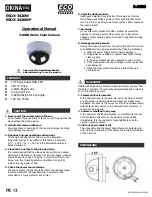
V1.02
Thom Hogan’s Complete Guide to the Nikon D300
Page 276
overexposures shown here are 1 1/3 stop—four bars from
the center correct position).
Manual exposure mode gives
you full control, much like the older “match-needle”
cameras that were prevalent in the early days of SLRs.
Many users gravitate to Manual exposure mode when
they want to make sure that a particular combination of
aperture and shutter speed is used (as when they meter
off one area and compose in another). Some
professionals use this exposure mode because it forces
them to deal with both their aperture and shutter speed
choice and can be a pragmatic way of “locking”
exposure.
Note: The references to Command dials in the previous and
following descriptions can be reversed by using Custom
Setting #F7 (see page <587>).
õ
To select the exposure mode, press the
MODE
button on
the top of the camera (behind the shutter release) and use the
Rear Command dial to chose the desired exposure mode
(displayed as
P
,
A
,
S
, or
M
on the top LCD; a
*
indicates
you’re in Flexible Program exposure mode).
Top LCD:
Note: If the lens mounted on the D300 does not have what Nikon
calls a CPU
88
(i.e. it is an AI or AI-S lens) and you are in
matrix metering with Program, or Shutter-priority exposure
mode set, the camera won’t take a picture. Switch to
88
It’s not actually a central processing unit as the name implies, but rather a chip that
passes on a set of values that describe a few pieces of data about the lens (maximum
aperture, focal length, focus distance).
















































